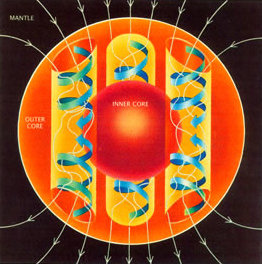 |
| Convection currents of magma in the outer core |
With the paleomagnetic record as leading indicator, Earth's magnetic poles are poised to reverse within the next few thousand years.
Earth's Magnetic Field
A molten iron core generates Earth's magnetic field. Loosely analogous to an electrical generator, Earth's magnetic field is created by the convection of magma in its outer core.
The turbulent convection of molten iron is driven by radioactive heating. This movement produces electrical and magnetic energy. The currents cause the magnetic field surrounding the planet.
Geomagnetism is an ongoing and self-sustained process provided there is sufficient energy to convect flow in the outer core.
Geophysicists attribute shifting currents within the molten core as the cause for the drifting of the magnetic poles. Magnetic North drifts about 10 miles a year.
The positions of Magnetic North and Magnetic South appear destined to flip-flop as they have many times over the course of many millions of years.
What's past is prologueAncient Polarity
— William Shakespeare, The Tempest.
Geomagnetic reversals have occurred frequently over the past 169 million years. Paleomagnetic evidence is found in rocks on the ocean floor and in some lava flows.
Geomagnetic polarity is shown (image right) as time descends back in time from present day (top) to the Jurassic period (bottom). Polarity has flipped between the normal configuration we observe today (black stripes) and the reverse configuration we observe in the paleomagnetic record (white stripes).
The Cenozoic era ranges from present day to 66 million years ago. The Mesozoic era ranges from the beginning of the Cenozoic era to 252 million years ago. The Cenozoic, known also as the Age of Mammals, is derived from a composite of the Greeks words for new and life.
Conscience is our magnetic compass; reason our chart.
— Joseph Cook
REFERENCES
- Geomagnetic Reversal, Wikipedia.
- Geomagnetism Program, USGS.
- How does the Earth's core generate a magnetic field?, USGS.
- Understanding Ancient Geomagnetic Reversal, Phys.org Earth Sciences, 22 December 2014.
_(NSF).jpg/600px-Research_on_Iceberg_B-15A_by_Josh_Landis%2C_National_Science_Foundation_(Image_4)_(NSF).jpg)











